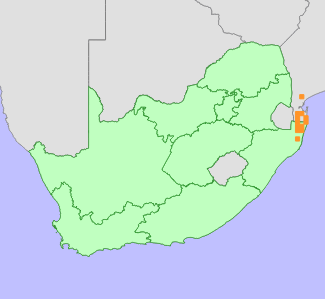|
Scientific Name | Sclerochiton apiculatus Vollesen |
Higher Classification | Dicotyledons |
Family | ACANTHACEAE |
Synonyms | Sclerochiton coeruleus of other authors, not of (Lindau) S.Moore (misapplied name) |
Common Names | Blue Lips (e) |
National Status |
Status and Criteria | Vulnerable B1ab(ii,iii)+2ab(ii,iii) |
Assessment Date | 2016/11/21 |
Assessor(s) | H. Matimele, D. Raimondo & J.E. Burrows |
Justification | Sclerochiton apiculatus has a restricted range (global EOO 11 291 km², AOO <2000 km²), and in South Africa it is known from eight locations. It is declining across its range due to ongoing habitat loss and degradation, and therefore the national status is not adjusted following IUCN regional assessment procedures. |
Distribution |
Endemism | Not endemic to South Africa |
Provincial distribution | KwaZulu-Natal |
Range | A Maputaland endemic, occurring from False Bay Park in KwaZulu-Natal, South Africa to Chinhanguanine in the Moamba District in southern Mozambique. |
Habitat and Ecology |
Major system | Terrestrial |
Major habitats | Maputaland Pallid Sandy Bushveld, Sand Forest, Northern Coastal Forest |
Description | A vine or small shrub known to occur on well-drained sandy soils in dry semi-deciduous coastal forest (sand forest) as well as in thicket and riverine forest at low altitudes (Vollesen 1991, Boon 2010). There is no information on the impact of fire on this species, but since it is mainly associated with forests and thickets that do not burn naturally, it is suspected that it is not adapted to fire. |
Threats |
| The population is declining due to ongoing habitat loss to urban expansion, infrastructure development, crop cultivation and road construction. Shifting agriculture is causing extensive habitat degradation across its range in southern Mozambique and northern KwaZulu-Natal. Unsustainable firewood collection is causing widespread forest degradation, and in southern Mozambique coastal forests are increasingly being cleared for charcoal production. Overstocking of reserves with animals, particularly elephants, is also causing ongoing habitat degradation even inside protected areas. |
Population |
Population trend | Decreasing |
Assessment History |
Taxon assessed |
Status and Criteria |
Citation/Red List version | | Sclerochiton apiculatus Vollesen | VU B1ab(ii,iii)+2ab(ii,iii) | 2017.1 | | Sclerochiton apiculatus Vollesen | Least Concern | Raimondo et al. (2009) | |
Bibliography |
Boon, R. 2010. Pooley's Trees of eastern South Africa. Flora and Fauna Publications Trust, Durban.
Raimondo, D., von Staden, L., Foden, W., Victor, J.E., Helme, N.A., Turner, R.C., Kamundi, D.A. and Manyama, P.A. 2009. Red List of South African Plants. Strelitzia 25. South African National Biodiversity Institute, Pretoria.
Vollesen, K. 1991. A revision of the African genus Sclerochiton (Acanthaceae: Acantheae). Kew Bulletin 46(1):1-50.
|
Citation |
| Matimele, H., Raimondo, D. & Burrows, J.E. 2016. Sclerochiton apiculatus Vollesen. National Assessment: Red List of South African Plants version 2024.1. Accessed on 2025/10/30 |
 Comment on this assessment
Comment on this assessment

